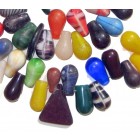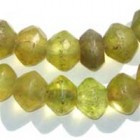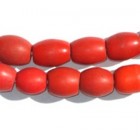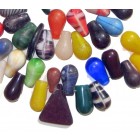
“Mali Wedding Beads” collectively refers to a variety of bulbous and colorful Czech trade beads manufactured in Bohemia (now Czechoslovakia) between the 19th and 20th century. Their name derives from the popularity among the Fulani people of Mali, who traditionally present them to their daughters on the eve of her wedding.

Mali Wedding Beads
Mali Wedding Beads are among the earliest types of Bohemian trade beads to be produced using the mechanical pressing method, originally patented in France by Jean-Felix Bapterosses in 1843. Molten glass is distributed into molds, then fired under pressure to achieve a uniform shape. Pressed beads typically have a visible seam running the entire perimeter of the bead, although in the case of Mali Wedding Beads, was often ground down by hand to achieve a smooth finish.
“Fulani Wedding Beads”, as they are also known, come in a wide range of sizes and shapes. The most common varieties resemble pineapples and light bulbs, with a horizontal perforation at the top, however, they were also produced in triangular and ‘claw’ shapes. Hourglass and pineapple beads are highly prized by women of the Fulani tribe, since they closely resemble the female form. In rural parts of Mali, such beads are still believed to aid female fertility.
Early Mali Wedding Beads were typically produced in opaque, single colors, however, as technology advanced, Czech glass-makers began to experiment with different combinations to produce both striped and speckled varieties. Today, Mali Wedding Beads can be found in just about every shade of the spectrum, with a wide range of effects and finishes.
Vaseline Beads are a variety of Czech trade bead originally manufactured in Bohemia (present day Czechoslovakia) between the late 19th and early 20th century. Their name derives from their distinctive translucent yellow color – similar to that of Vaseline/ petroleum jelly. Vaseline Beads are also known as “Uranium Glass Beads” owing to the small quantities of the element used to influence their color.

Yellow Vaseline Beads
When mixed with glass, either as an oxide or in the form of salts, uranium has a tendency to alter the structural properties of the glass, causing it to glow a green-yellow color in ultra-violet light. The quantity used had a significant impact upon the color of the glass, which is why some early 19th century Vaseline Beads are almost milky white in color. The growing fascination with uranium glass influenced a period of mass production in Europe from 1905; ironically, the same point at which Bohemia held the monopoly for mass bead production.
According to trade records, Vaseline Beads were produced to demand in Bohemia for English, Italian, and Spanish merchants. The expense of producing these beads on such a massive scale was soon felt by glass-makers in Bohemia, and they set about experimenting with different quantities of Uranium to glass to determine exactly how much was needed to influence fluorescence in ultra-violet light. As it turned out, the ratio of salts to glass needed was little more than 1-2%, prompting more glass factories to begin accepting orders from European merchants. The effects of World War I and the Great Depression meant that demand for Vaseline glass declined considerably during the mid 1920s, and by the time the Communists seized power in Bohemia, Vaseline Beads were largely obsolete.
Bohemian Vaseline Beads produced during the 19th and early 20th century are distinguishable from later imitations by their cut and shape. They were commonly made in either rondelle, bicone or disc form, with distinctive hand-cut facets. Older beads tend to be milky white in appearance, while those manufactured from 1905 onwards were typically more amber-yellow in color.
References:
Uranium Glass, Wikipedia
Colodonte Beads (also known as “tomato”, “pigeon egg” and “hummingbird egg” beads) are a type of wound, drawn bead originally produced in Bohemia (now Czechoslovakia) during the 1900s. The modern nicknames given to these beads derive from the fact they bear a close resemblance in shape to the eggs of small wild birds. Early Colodonte Beads were predominantly opaque red or burnt orange in color – hence their sometimes being referred to as “tomato beads”.

Red Colodonte (Tomato) Beads
The mysterious history of Colodonte Beads has led to considerable speculation in online forums as to their intended use. The name “Colodonte” is believed to be of Italian origin; “colo” deriving from the Italian word “colore” (meaning color), and “donte”, which loosely translated means “everlasting”. However, there is no evidence to suggest that these beads were produced in Venice, lending credibility to the theory that artisans in Bohemia may have been producing them specifically for Italian merchants to use as currency overseas. The vast majority of old Colodonte Beads sold today originate from present day Mali and other coastal parts of West Africa.
Colodonte Beads are distinguishable from other Bohemian Trade Beads by their oval shape and smooth finish. The blemish free, glossy skin of the beads is similar in appearance to tomato skin – perhaps another reason they earned the moniker “tomato beads”. Nearly all trade beads of this type are round or oval in shape, however can vary in size from 20 – 40 mm in diameter. Colodonte Beads manufactured during the 19th Century typically suffer minor pitting – a tell-tale sign of their age and fascinating history.
Bohemian, or “Czech” Trade Beads refer to a variety of glass beads produced in Bohemia (now Czechoslovakia) during the 19th and early 20th Century, primarily for use by European merchants during trade missions to Africa, Asia and North America. Czech Trade Beads encompass a wide range of bead formats, ranging from bulbous Mali Wedding Beads and oval Colodonte Beads to faceted, radioactive Vaseline Beads.
Bohemia has a long and fascinating history of glass production, believed to date back to the times of Roman occupation in 400 A.D. Records show there were a number of small factories producing glass beads for rosaries in Bohemia around the 12th Century, however, it wasn’t until the 1500s that these cottage industry crafters began to expand to cities such as Jablonec and Reichenburg.
Glass bead production reached its peak in Bohemia during the 19th Century, and is largely attributed to the ‘bead researchers’ who

Large Mali Wedding Beads
traveled across Europe surveying merchants about the kind of beads most popular among African and North American tribes. Armed with this information, they returned to Bohemia with sketches of prototypes for factory owners. The industrial age also marked a turning point for bead production. New machines and techniques were introduced, allowing for greater control over the uniformity and quality of beads, as well as the speed of production. While Venice set the benchmark for beads of intricate beauty, Bohemia flourished by mass producing relatively plain glass trade beads to order.
Bohemia’s bead-making industry continued to thrive until well into the 1920′s until a series of historic events – namely the Great Depression and World War II – forced the closure of many bead factories in Jablonec. It was during this time that many of the beads produced in the 1900s began to realize considerable value on the Western market. Today, both Mali Wedding Beads and Colodonte Beads are highly collectible; some strands fetching in the region of $200-$300!
References:
The History of Czech Glass, Harlequin Beads.
Green Heart Beads (also known as “Hudson’s Bay Trade Beads”, or more simply “Green Hearts”) are a collectible variety of Venetian trade bead produced between 1480 and the 1800′s in Murano, Venice. They are descended from the two-tone compound beads known as “White Hearts” or “Cornaline D’Aleppo”, which were manufactured exclusively as a medium of exchange (currency) for furs in North America and Africa by the Hudson’s Bay Trading Company.

Old Green Heart Trade Beads.
Green Heart Beads are distinguishable from Cornaline D’Aleppo by their brick red color and translucent green core. White Hearts are typically ruby or scarlet red with a translucent white or gray core. The coloration of these popular Venetian glass beads was achieved by adding gold oxide to pink or purple glass. Initially, glass-makers were using gold oxide to produce beads in red only (possibly to imitate the popular carnelian beads traded in Africa), however this proved too expensive long-term. They decided to produce cheaper beads by creating a translucent core from untreated glass, and simply coating it with a thin layer of red colored glass. Green was used for the core until 1830, after which white and yellow glass were used.
Like Cornaline D’Aleppo, Green Heart Beads were produced in limited quantities between 1480 and 1830 due to the sheer expense involved. Because of their scarcity, they’re widely considered to be some of the most valuable and collectible types of trade beads on the market today.
White Heart Beads (also referred to as “Cornaline D’aleppo“, or “Hudson’s Bay Beads”) were a type of Venetian Trade Bead produced in Venice, Italy, between 1805 and 1900. While highly collectible, these two-tone beads are considerably plainer compared to other sought after trade beads of the time, such as Millefiori Beads, with an off-white or light yellow core enveloped by a skin of scarlet, orange or dark red glass. Historical findings suggest the brilliant red of some White Heart Beads was achieved by adding gold oxide to the glass.

Red White Heart Beads (Cornaline D’Aleppo)
White Heart Beads were traded extensively throughout Africa and North America in the 19th Century, however, the name “Cornaline D’Aleppo” is believed to derive from the old trading town, Aleppo, in Syria. Being a popular stop-off for caravanning merchants en route to the Middle East from the Mediterranean, the town became a thriving marketplace, and an important center for trade between nomadic African tribespeople and Europeans. “Cornaline”, the old French word for “carnelian”, suggests the beads could have been produced as imitations to fool African tribes.
Venetian White Heart Beads tend to be round or oval in shape, however, there is evidence to suggest both the French and Czechs produced similar beads in the 19th Century in a wide range of shapes and sizes. Although similar in aesthetics to White Hearts, Green Heart Beads usually have a green or grayish core.